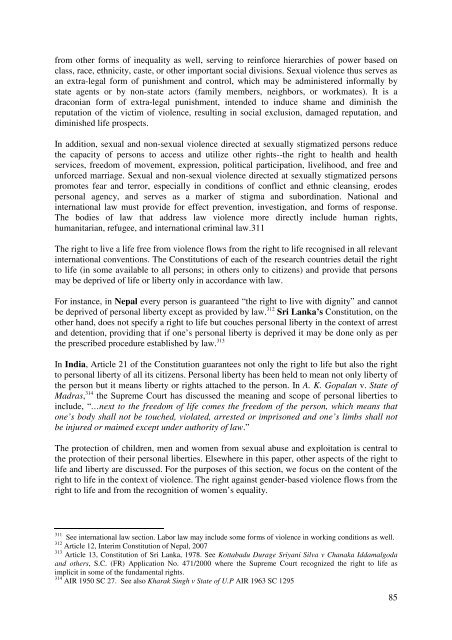SEXUAL HEALTH AND HUMAN RIGHTS A legal and ... - The ICHRP
SEXUAL HEALTH AND HUMAN RIGHTS A legal and ... - The ICHRP
SEXUAL HEALTH AND HUMAN RIGHTS A legal and ... - The ICHRP
You also want an ePaper? Increase the reach of your titles
YUMPU automatically turns print PDFs into web optimized ePapers that Google loves.
from other forms of inequality as well, serving to reinforce hierarchies of power based on<br />
class, race, ethnicity, caste, or other important social divisions. Sexual violence thus serves as<br />
an extra-<strong>legal</strong> form of punishment <strong>and</strong> control, which may be administered informally by<br />
state agents or by non-state actors (family members, neighbors, or workmates). It is a<br />
draconian form of extra-<strong>legal</strong> punishment, intended to induce shame <strong>and</strong> diminish the<br />
reputation of the victim of violence, resulting in social exclusion, damaged reputation, <strong>and</strong><br />
diminished life prospects.<br />
In addition, sexual <strong>and</strong> non-sexual violence directed at sexually stigmatized persons reduce<br />
the capacity of persons to access <strong>and</strong> utilize other rights--the right to health <strong>and</strong> health<br />
services, freedom of movement, expression, political participation, livelihood, <strong>and</strong> free <strong>and</strong><br />
unforced marriage. Sexual <strong>and</strong> non-sexual violence directed at sexually stigmatized persons<br />
promotes fear <strong>and</strong> terror, especially in conditions of conflict <strong>and</strong> ethnic cleansing, erodes<br />
personal agency, <strong>and</strong> serves as a marker of stigma <strong>and</strong> subordination. National <strong>and</strong><br />
international law must provide for effect prevention, investigation, <strong>and</strong> forms of response.<br />
<strong>The</strong> bodies of law that address law violence more directly include human rights,<br />
humanitarian, refugee, <strong>and</strong> international criminal law.311<br />
<strong>The</strong> right to live a life free from violence flows from the right to life recognised in all relevant<br />
international conventions. <strong>The</strong> Constitutions of each of the research countries detail the right<br />
to life (in some available to all persons; in others only to citizens) <strong>and</strong> provide that persons<br />
may be deprived of life or liberty only in accordance with law.<br />
For instance, in Nepal every person is guaranteed “the right to live with dignity” <strong>and</strong> cannot<br />
be deprived of personal liberty except as provided by law. 312 Sri Lanka’s Constitution, on the<br />
other h<strong>and</strong>, does not specify a right to life but couches personal liberty in the context of arrest<br />
<strong>and</strong> detention, providing that if one’s personal liberty is deprived it may be done only as per<br />
the prescribed procedure established by law. 313<br />
In India, Article 21 of the Constitution guarantees not only the right to life but also the right<br />
to personal liberty of all its citizens. Personal liberty has been held to mean not only liberty of<br />
the person but it means liberty or rights attached to the person. In A. K. Gopalan v. State of<br />
Madras, 314 the Supreme Court has discussed the meaning <strong>and</strong> scope of personal liberties to<br />
include, “…next to the freedom of life comes the freedom of the person, which means that<br />
one’s body shall not be touched, violated, arrested or imprisoned <strong>and</strong> one’s limbs shall not<br />
be injured or maimed except under authority of law.”<br />
<strong>The</strong> protection of children, men <strong>and</strong> women from sexual abuse <strong>and</strong> exploitation is central to<br />
the protection of their personal liberties. Elsewhere in this paper, other aspects of the right to<br />
life <strong>and</strong> liberty are discussed. For the purposes of this section, we focus on the content of the<br />
right to life in the context of violence. <strong>The</strong> right against gender-based violence flows from the<br />
right to life <strong>and</strong> from the recognition of women’s equality.<br />
311 See international law section. Labor law may include some forms of violence in working conditions as well.<br />
312 Article 12, Interim Constitution of Nepal, 2007<br />
313 Article 13, Constitution of Sri Lanka, 1978. See Kottabadu Durage Sriyani Silva v Chanaka Iddamalgoda<br />
<strong>and</strong> others, S.C. (FR) Application No. 471/2000 where the Supreme Court recognized the right to life as<br />
implicit in some of the fundamental rights.<br />
314 AIR 1950 SC 27. See also Kharak Singh v State of U.P AIR 1963 SC 1295<br />
85

















